  This motor uses the static electricity from your TV screen to power a motor made from pop cans and a styrofoam coffee cup.
This motor uses the static electricity from your TV screen to power a motor made from pop cans and a styrofoam coffee cup.
You'll need a paper plate, two pop cans, a styrofoam cup, two paperclips, some wire, a cheap ball point pen, aluminum foil, tape, and some glue. You'll also need some scissors, and some sort of pliers that can cut a pointed end on a paperclip We used wire test leads with alligator clips at the ends to make attachments more quickly, but if you don't have any of these, you can attach the wires with tape. Don't use contact cement; we discovered too late that it dissolves styrofoam, and had to start over! Instead we used a hot-glue gun and plain white glue. 
 Begin by glueing two pieces of aluminum foil to the outside of the styrofoam cup, using white glue.
Begin by glueing two pieces of aluminum foil to the outside of the styrofoam cup, using white glue.Cut them and attach them so that two half-inch gaps are left on opposite sides of the cup, as shown at the right. Smooth them out to flatten the wrinkles, and make sure the edges of the foil are glued down flat. You might also want to trim the uncovered styrofoam rim below the foil, to make the cup lighter; we didn't do that. 
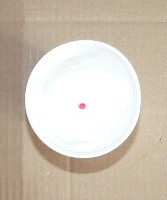 Next, remove the end plug from the ball point pen. Trim it so it's quite short; the metal tip of the pen will sit inside the hollow end of this plug.
Next, remove the end plug from the ball point pen. Trim it so it's quite short; the metal tip of the pen will sit inside the hollow end of this plug.Attach the flat side of the plug, using hot glue, to the exact centre of the inside bottom of the cup. Make sure it really is centred exactly, and sitting flat on the bottom. Place the metal end of the pen into this little plug, balancing the cup upside down on the pen, and spin it to make sure the plug is centred and that the cup spins easily. 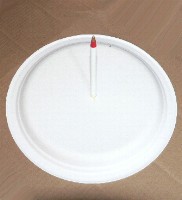
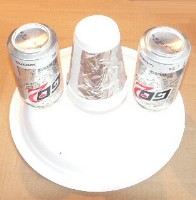
Glue the end of the pen to the centre of the back of the paper plate, using hot glue, as shown in the photo at the left. Place the cup upside down on the pen, making sure the tip fits into the plug. Then glue the two pop cans upside down onto either side of the cup, leaving half an inch or so of space between the cans and the cup, so the cup can spin without touching them. Now prepare the paperclips. Do the following to each paperclip: straighten two of the bends, leaving one bend at the end. Twist the paperclip into an 'S' shape. Now take one of the paper clips and tape the bent end onto the right can, as shown in the photo below left. Make sure the sharpened straight end is pointed directly at the foil on the cup, about a half inch away; the pointed end should be the closest part of the paperclip to the cup. Next, do the same thing to the other paperclip, on the left can. When you're done, the set-up should look like the photo at the right below. 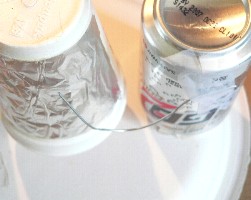
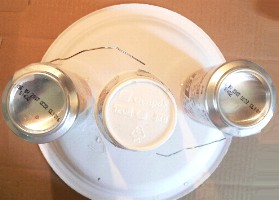 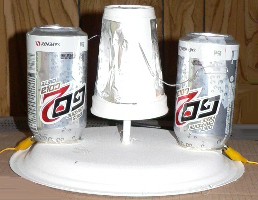 The final step is to attach each of the two wires. The wire attached to the right can is also attached to a sheet of aluminum foil. The wire attached to the left can will be the ground wire.
The final step is to attach each of the two wires. The wire attached to the right can is also attached to a sheet of aluminum foil. The wire attached to the left can will be the ground wire.Place the apparatus near an older television, and spread the foil across the screen. Hold the left wire in your hand ... your body will be the ground. Give the cup a slight turn if necessary, so that the pointed ends of the wire are next to the foil rather than the gaps between. Now turn the TV on. The cup should begin to turn. As it slows down, turn the TV off. This will cause the cup to turn some more. Continue turning the TV on and off to make the cup motor keep turning. 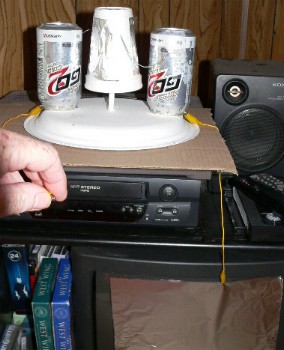 How It Works:
How It Works:The right can and the paperclip attached to it get charged up with electrons from the TV screen. These excess electrons on the can and paperclip are under pressure to escape, and this pressure is highest at the very tip of the paperclip. The pressure of electrons is so high there that they can jump off into the nearby air! This causes the air near the tip of the paperclip to become negatively charged, and it is then repelled by the still negative paperclip. The negatively charged air moves away from the paperclip and towards the nearest piece of foil, which they jump on to. Now this foil is negatively charged, along with the right can, and they repel each other. The foil, being attached to the cup, can rotate away from the can, and it does. But there's more. The negatively charged foil repels the electrons in the left can, leaving behind a positive charge on the left can, which now can attract the foil. So this also helps to rotate the cup. After the cup has revolved half way, the excess electrons can escape in a similar fashion - through the air onto the left can, and out through the ground. This leaves the original piece of foil neutral and ready to begin the cycle over again. Meanwhile, the other piece of foil is going through the whole process too. |